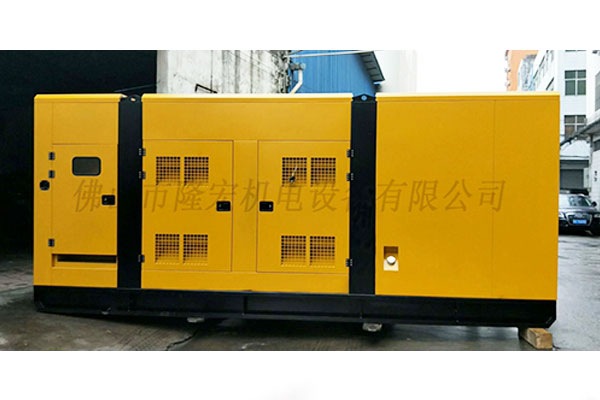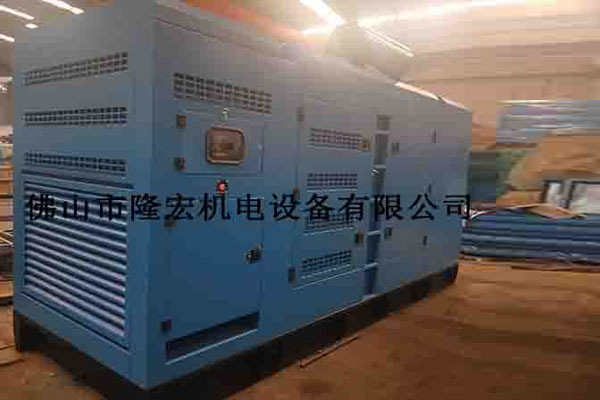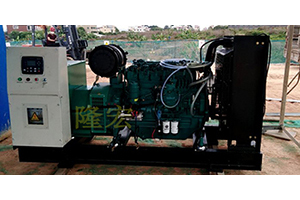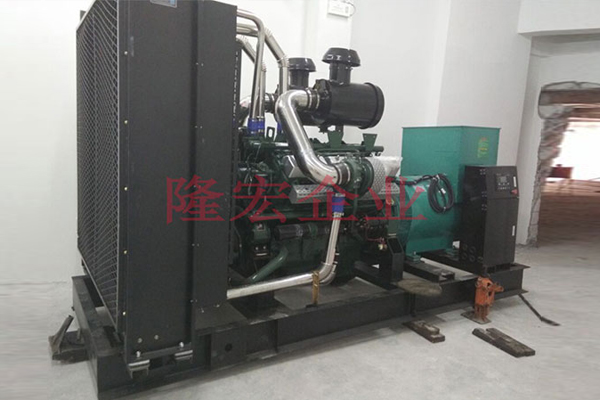Parallel control of diesel generator set
1、 What are the conditions for parallel operation of generating units?
The whole process of generating units put into parallel operation is called parallel operation. When one generator set is put into operation, the voltage is sent to the bus. After the other generator set is started, it is paralleled with the previous generator set. At the moment of closing, the generator set shall not have harmful impact current and the shaft shall not be subject to sudden impact. After closing, the rotor should be able to be pulled into synchronization quickly. (i.e. the rotor speed is equal to the rated speed) therefore, the following conditions must be met for generator set paralleling:
1. The effective value and waveform of generator set voltage must be the same
2. The voltage phase of two generators is the same
3. The frequency of two generator sets is the same
4. The phase sequence of two generating units is consistent
2、 What is the quasi synchronous parallel method of generating units? How to carry out synchronous parallel operation?
Quasi synchronization is the exact period. If the quasi synchronization method is used for parallel operation, the voltage, frequency and phase of generator sets must be the same. This can be monitored by two voltmeters, two frequency meters, synchronous meter and non synchronous indicator light installed on the synchronization panel. The parallel operation steps are as follows:
Turn on the load switch of one generator set and send the voltage to the bus, while the other unit is in standby state.
Close the synchronization start, adjust the speed of the generator set to be merged to make it equal to or close to the synchronous speed (the frequency difference with the other unit is within half a cycle), and adjust the voltage of the generator set to be merged to make it close to the voltage of the other generator set. When the frequency and voltage are similar, the rotation speed of the synchronization meter is slower and slower, and the synchronization indicator light is on and off; When the phase of the unit to be merged is the same as that of the other unit, the pointer of the synchronization meter indicates the middle position upward, and the synchronization light is the darkest. When the phase difference between the unit to be merged and the other unit is the largest, the synchronization meter points to the center position below, and the synchronization light is the brightest. When the pointer of the synchronization meter rotates clockwise, it indicates that the frequency of the generator to be merged is higher than that of the other unit Reduce the speed of the generator set to be merged. On the contrary, when the pointer of the synchronous meter rotates anticlockwise, the speed of the generator set to be merged shall be increased. When the pointer of the synchronous meter slowly rotates clockwise and the pointer is close to the synchronization point, the circuit breaker of the unit to be paralleled shall be closed immediately to make the two generator sets in parallel. After paralleling, cut off the synchronous meter switch and related synchronization switch.
3、 What should be paid attention to in the quasi synchronous parallel operation of generating units?
Quasi synchronous parallel operation is manual operation. Whether the operation is smooth or not is closely related to the experience of operators. In order to prevent non synchronous parallel operation, the following three conditions are not allowed to switch on.
1. When the pointer of the synchronous meter jumps, it is not allowed to switch on, because there may be a tape jam inside the synchronous meter, which can not reflect the correct parallel conditions.
2. When the synchronous meter rotates too fast, it indicates that the frequency difference between the generator set to be paralleled and the other generator set is too large. As the closing time of the circuit breaker is difficult to master, the circuit breaker is not closed at the synchronization point, so it is not allowed to close at this time.
3. If the pointer of the synchronous meter stops at the synchronization point, it is not allowed to switch on. This is because if the frequency of one generator unit changes suddenly during the closing process of the circuit breaker, the circuit breaker may be closed at the non synchronous point.
4、 How to adjust the reverse work phenomenon of parallel units?
When two generating units are paralleled without load, there will be a problem of frequency difference and voltage difference between the two units. Moreover, on the monitoring instruments (ammeter, power meter and power factor meter) of the two units, the actual reverse power situation is reflected. One is the reverse work caused by inconsistent speed (frequency) and the other is caused by unequal voltage. The adjustment is as follows:
1. Adjustment of reverse power phenomenon caused by frequency: if the frequency of two units is different and the difference is large, the instrument (ammeter and power meter) shows that the current of the unit with high speed shows positive value, and the power meter indicates positive power; otherwise, the current indicates negative value and power indicates negative value. At this time, adjust the speed (frequency) of one of the units, adjust it according to the indication of the power meter, and adjust the indication of the power meter to zero. The power indication of the two units is zero, so that the speed (frequency) of the two units is basically the same. However, when the ammeter still has indication, this is the reverse work phenomenon caused by voltage difference.
2. Adjustment of reverse power phenomenon caused by voltage difference: when the power meter indication of two units is zero, and the ammeter still has current indication (i.e., one reverse and one positive indication), the voltage adjustment knob of one generator set can be adjusted. The adjustment is carried out according to the indication of ammeter and power factor. If the indication of ammeter is eliminated (i.e. adjusted to zero), then according to the indication of power factor meter, the power factor can be adjusted to 0.5 or above. Generally, it can be adjusted to about 0.8, which is the best state.
5、 Generator protection circuit
1. The phenomenon of reverse work and reverse work is caused by different speed (frequency) and voltage of generator set, that is, one generator set has positive power, while the other unit has negative power. That is to say, the unit with negative power becomes a load (the frequency of the unit is low and the speed is inconsistent). When the voltage is different, the unit with high voltage will provide a reactive current and voltage (the positive indication of ammeter of this unit) to the unit with low voltage, which is equivalent to adding a condenser group in the power supply system. The unit with low voltage becomes a large load and receives a large reactive current to maintain the voltage balance of the two units (the ammeter of the unit indicates in reverse). When the rated voltage of one unit is higher than 20%, the current of another unit will be adjusted to high or low power. Reverse acting relay acts, trips and alarms, but does not stop.
2. Over current: the rated power of the current generator set is fixed, and its overload capacity is very low, which is basically about 5% of the rated power. The allowable load time is 15-30 minutes, and the maximum is not more than 60 minutes. Beyond this time, the generator set will heat up, the insulation of the conductor will be reduced, and the service life will be reduced. Therefore, when setting the over-current protection, if there is no special requirement, the over-current protection can be set at 110% of the rated current. During the load test, the current is brought to 110% of the rated current, and the over-current relay acts. Trip, alarm, no shutdown.
3. Overvoltage: when the generator sets are used in parallel, the most fear is that the power supply system will oscillate. Once the oscillation occurs, the voltage of the system will rise, which will easily lead to the insulation breakdown of the electrical equipment and the power supply equipment, making the power supply equipment and the electrical equipment paralyzed together. For this reason, the generator sets used in parallel are equipped with over-voltage protection, and the setting value of 105% of rated voltage is the best. Short circuit overvoltage relay, trip stop, alarm action
6、 Opening and closing circuit opening and closing circuit are connected to the mobile phone parallel, automatic parallel control circuit.
1. Manual opening and closing: each unit can be used as the first machine or waiting for parallel opening and closing. When manual parallel operation or power supply is adopted, manual opening and closing can be used.
2. Automatic opening and closing: each unit can be selected as the unit to be merged or the first unit; after the first unit starts, the closing circuit will be automatically closed, and automatically put into and out of the same period. After synchronization, the units to be combined will be automatically closed and operated in parallel.
3. No matter whether it is manual closing or automatic closing, once the unit has reverse work and has passed low oil pressure, high water temperature, high oil temperature and over-voltage, all the automatic opening and disconnection will be separated from the load.
7、 Synchronous circuit
1. When the first machine is switched on, the power is sent to the bus. At this time, the bus detects the synchronization circuit and the synchronization circuit to be paralleled. After receiving the signal, it will automatically close the synchronization detection relay. The bus voltage and the voltage to be paralleled are sent to the synchronization control module, which automatically detects the voltage and speed of the parallel unit. If the speed is different, the synchronization module will automatically adjust the speed of the machine to be paralleled to make it reach the parallel condition. After finding the synchronization point, the synchronization module sends the closing instruction, and when the parallel unit receives the instruction, it executes the closing, that is, the two units operate in parallel.
2. After the units are paralleled, the synchronization circuit will automatically exit from the working state, but the automatic synchronization change-over switch must be manually withdrawn to prevent the parallel signal from being received by the unit to be paralleled again when the unit is disconnected after power supply, and the synchronization device will be automatically put into operation to make the unit parallel again.
8、 Load distribution
1. When the single machine is running, the load distributor does not work.
2. After the units are paralleled, the load distributor of each unit is put into operation at the same time, and their own speed is adjusted to make the power of the two units evenly distributed. Its working principle is to automatically adjust the speed of unit D according to the output power of the unit (i.e. the size of current) to balance the load.
9、 Voltage regulation circuit:
1. Before the units are paralleled, the voltage of the two units must be adjusted to the same value.
2. After no-load paralleling, adjust the voltage knob to eliminate the reverse power phenomenon and make the power factor lag about 0.8.
3. After the parallel units are loaded, the voltage adjustment knob can be manually adjusted according to the load conditions to make the power factor in the best position, and no further adjustment is needed in the future.
10、 Speed adjustment circuit
1. The speed (frequency) of the two units must be adjusted to be the same before paralleling.
2. When paralleling, the rotation speed of the first unit or the unit to be merged can be adjusted according to the rotation speed of the synchronous meter, so that the synchronous meter can rotate clockwise or anticlockwise. The slower the speed is, the better. However, the pointer of the synchronous meter must be rotated to parallel.
3. After paralleling, observe whether the current and power of the two units are balanced. If the difference is too large, adjust the speed knob to adjust the power of the two units to the same.
11、 Instrument detection loop:
1. Before operation, all kinds of related instruments must be adjusted to zero, but the power factor meter and frequency meter are not at zero.
2. During operation, observe the operation status of various instruments to see whether they meet the requirements (whether there is the phenomenon of instrument wiring reversed).
3. Check the current, voltage and indicator value with relevant instruments to see if they are normal.
12、 Starting circuit:
1. Check whether the starting circuit is normal before operation.
2. Whether the relevant components can work normally after startup.
3. Whether the combination of the starter and the host is normal and whether it can exit.
13、 Shutdown circuit:
1. Whether the action of shutdown electromagnet and solenoid valve is reliable.
2. Whether the unit stops automatically when the unit fails.
Whether the manual shutdown circuit is perfect.
4. Whether to shut down when only tripping is needed.
Popularmore>>
- Parallel control of diesel generator set
- In case of snow, the main points for attention of Weichai generator set
- Some problems of diesel generator set with load
- Brief introduction of automatic ATS switching of Weichai generating set
- Difference between brush motor and brushless motor
- It's cold. It's time to change antifreeze for your Weichai generator set





